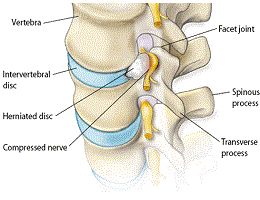The Primary Causes Of Sciatica
![]()

There are several lower back or lumbar spine problems which can cause sciatica. Sciatica is typically accompanied by pain in one of the legs. This pain can vary from mild to intense, but even at its lowest level is often very uncomfortable.
Sciatica is caused when one of more of the nerve roots located along the spine become compressed. Doctors may also define sciatica as radiculopathy which is the medical term to define numbness, pain, weakness, and tingling in the legs or arms. This pain is usually caused by some sort of nerve root problem. If the pain is coming from the neck, it is called cervical radiculopathy. Sciatica, however, is pain originating from the back, so it is called lumbar radiculopathy.
The Nerve Pathways
There are five sets of nerve roots which are paired together and located in the lumbar spine. Together these make up the sciatic nerve. The sciatic nerve runs from the back of the pelvis, under the buttock and then downward into each leg. Nerve roots do not exist in isolation but are part of the greater nervous system of the body. They can transmit sensation and pain to other parts of the body. When a nerve root is compressed, usually from a ruptured disc, it can create pain which radiates all the way down one or both legs.
Certain spinal disorders are more likely to create sciatic nerve compression. These include a herniated or bulging disc, spondylolisthesis, lumbar spinal stenosis, piriformis syndrome, a trauma to the spine, or spinal tumors.
The most common cause of sciatica is a bulging or herniated disc in the spinal column. When a disc bulges, the gel-like center, also called the nucleus pulposus is still contained within the outer wall of the disc. If a disc is herniated, then that nucleus has broken through the outer wall. Either way, the disc material can press against the adjacent nerve root, causing pain and sciatica.
From the physician’s viewpoint, the herniated disc is a more serious problem. This is because the disc material is no longer protected by the disc wall and can not only press on a nerve but may also cause nerve inflammation, making the pain worse. The nucleus material has an irritating chemical, hyaluronic acid which can cause the nerve to inflame. When this happens, the person may experience not only pain and inflammation in the nerve but also tingling and numbness in the extremities and even muscle weakness.
The disorder most often affecting the lumbar spine is Spondylolisthesis. This condition occurs when one vertebra has slipped forward over an adjacent vertebra. When this happens, the spinal nerve root is compressed creating sciatica pain in the leg. This condition is typically diagnosed at birth. It may also develop during childhood or can result from spinal degeneration, physical stress or trauma.
Another common cause of sciatica is lumbar spinal stenosis. This is often seen in older adults. It causes leg pain similar to sciatica, but the pain is usually located in one place or position and may be relieved by changing positions. The spinal nerve roots run down in branches from the spinal cord. They pass through openings in the spine and then extend into other parts of the body. If one of these spinal openings narrows or becomes clogged, the nerves may be compressed creating pain.
Piriformis syndrome is caused when the piriformis muscle irritates the sciatic nerve. This muscle is found in the lower spine. It connects the thighbone and also helps with hip rotation. The piriformis muscle is directly above the sciatica nerve. If spasms start in the piriformis muscle, they may cause this muscle to compress the sciatic nerve. Piriformis Syndrome can be difficult to diagnose and treat.
Sciatica may also result from a significant trauma to the sacral nerve roots or to the lumbar spine. These types of trauma include falls, vehicle accidents, and sports injuries.
Spinal tumors are rarer than these other conditions, but when they occur in the lumbar region, they may cause sciatica by compressing a nerve root.
Sciatica, while painful is treatable. If you believe you may have sciatica, meet with your physician to discuss your treatment options. There is no reason to live in pain…

 DietTalk.com was put together by a team of writers in order to help men and women from all over the world to live a healthy life. In our site we offer tips, advice and in-depth reviews about health related topics, including weight loss, fitness, muscle building, nutrition and different diseases and conditions.
DietTalk.com was put together by a team of writers in order to help men and women from all over the world to live a healthy life. In our site we offer tips, advice and in-depth reviews about health related topics, including weight loss, fitness, muscle building, nutrition and different diseases and conditions.








 We invest lots of efforts and time in order to provide you with the best content we can. As a result, unauthorized use and/or duplication of content on this site without express and written permission from this website’s owner is strictly prohibited. Please contact us if you have any question regarding this notice.
Thank you
We invest lots of efforts and time in order to provide you with the best content we can. As a result, unauthorized use and/or duplication of content on this site without express and written permission from this website’s owner is strictly prohibited. Please contact us if you have any question regarding this notice.
Thank you

